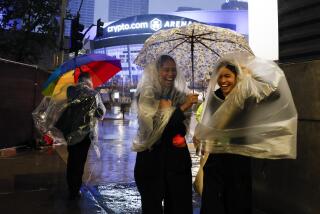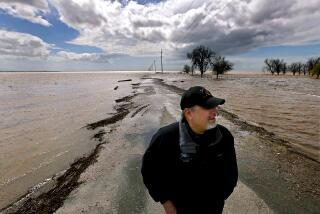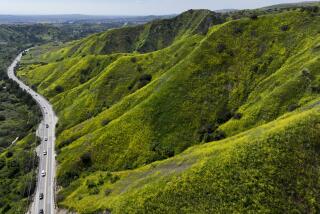Stateâs in a drought, but itâs not the worst ever
The warnings have been ominous this winter: California is headed into the worst drought in modern history. The water supply is drying up. Or, as one water association declared last week, âThings just keep getting worse and worse.â
Is it really that bad?
If you look at the numbers, the answer is no. Not only have a series of February storms pushed up mountain snowpack levels, but by historical standards the current three-year drought is far from the worst.
Monday, the state Department of Water Resources announced that the mountain snowpack that feeds the stateâs reservoirs has reached 80% of normal for the date. Precipitation in the northern and southern Sierra has climbed above 90% of average and another storm is on the way.
âRight now it doesnât look too bleak,â said Maury Roos, the stateâs chief hydrologist. âI think weâll have more runoff than last year.â
The water interests who have spit out grim news releases the last two months were silent Monday in the face of the growing snowpack.
Those who would like to build new reservoirs and canals and to weaken environmental regulations have invoked the drought like a mantra in recent weeks.
A recently introduced congressional bill that would allow federal officials to relax endangered-species protections in the Sacramento-San Joaquin Delta is titled the California Drought Alleviation Act.
âFor over 100 years in California, the drought argument has been used consistently to justify actions, and I think this is no exception,â said Robert Wilkinson, director of the Water Policy Program at UC Santa Barbaraâs Bren School of Environmental Science and Management.
In late January, a public relations firm representing state water contractors trumpeted: âCaliforniaâs water supply dries up.â It was highlighting the need for a delta âfix,â including a canal bypass.
Sen. Dave Cogdill, a Republican who represents agriculture-dependent Modesto, called the drought âepicâ when he introduced a $10-billion water bond package last week that includes funding for new reservoirs and other infrastructure.
State and federal water managers earlier this year sought to relax delta water quality standards, arguing that because of the drought, it needed to hold more water in upstream reservoirs to preserve cold water flows for salmon in coming months.
Los Angeles Mayor Antonio Villaraigosa last month called for fee increases and outdoor watering restrictions, citing the stateâs âsevere water shortages.â
The state is in a drought. But itâs ânot the worst weâve had,â said Roos, chief hydrologist for two decades.
Roos looks at two water supply criteria to determine whether the state is in a drought: Runoff from the stateâs major river systems has to be in the bottom 10% of the record, and total statewide reservoir storage has to be at or below 70% of average.
By that definition, 2007 and 2008 barely made the drought category.
In 1977, the water year (which ends Sept. 30) was the driest on record. Back then, statewide reservoir storage was 35% of average. Statewide storage was more than twice that by the end of September last year, and in 2007. Roos estimated it is about 70% of the norm now, a little less than halfway into the water year.
Roos said it was prudent for water managers to be conservative. âBut some of the statements have been pretty grim . . . The climate can change pretty fast.â
Said Peter Gleick, president of the Pacific Institute in Oakland and one of the worldâs leading experts on water issues: âThe state is still dry, but itâs a lot less dry then it was three weeks ago and decisions about water allocations and water policy ought to be done with the best current information.â
Even as reservoir and snowpack levels were rising, federal water managers announced last week that they might not make deliveries to some big Central Valley farms -- a scenario Gleick doubts will play out.
âItâs extremely likely that the allocations for the [federal Central Valley Project] are going to go up . . . The idea that theyâll give zero water to farmers -- thatâs not going to happen.â
Lester Snow, director of the state Department of Water Resources, defended his agencyâs characterizations of the drought, saying that though it may not be the worst hydrologically, other factors are accentuating its seriousness.
There are more people in the state, more farmers have switched to permanent crops that canât be fallowed and growing environmental problems in the delta have restricted water deliveries.
âSo the same level of hydrology [that the state experienced] in 1991 produces more severe impacts,â Snow said. âThatâs what spurs us to talk about the potential for the worst drought.â
--
More to Read
Sign up for Essential California
The most important California stories and recommendations in your inbox every morning.
You may occasionally receive promotional content from the Los Angeles Times.











